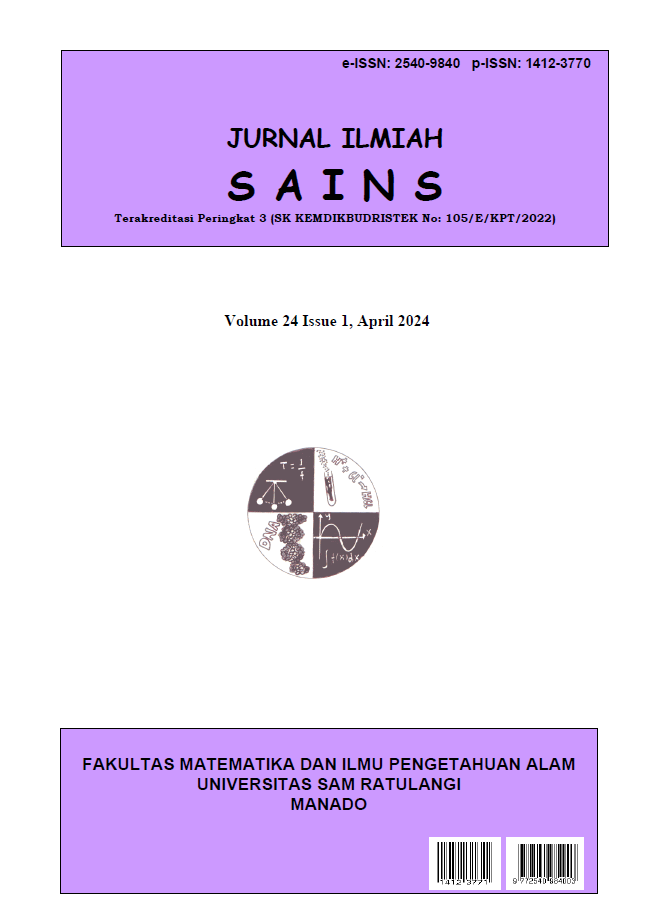Comparison of the Toxicity of Watermelon Rind Extract (Citrullus lanatus) and Melon Rind Extract Using BSLT Method
DOI:
https://doi.org/10.35799/jis.v24i1.49263Keywords:
Citrullus lanatus, Cucumis melo, LC50, toxicityAbstract
Toxicity analysis is a preliminary test to observe a toxic pharmacological activity to find a safe dose to be developed into a new drug. The plants that potentially have poisonous effects are Watermelon rind (Citrullus lanatus) and Melon rind (Cucumis melo). The purpose of this study was determine the toxic potential of watermelon rind and melon rind using Brine Shrimp Lethality Test. Test BSLT and phytochemical screening. The results of research on watermelon rind and melon rind contain secondary metabolites, amely alkaloids, flavonoids, tannins, saponins. The result of the BSLT test watermelon rind extract and melon rind extract were different. For watermelon rind extract, the LC50 value was 305,19 µg/ml and for melon rind extract, the LC50 value was 816,73 µg/ml. The LC50 value pbtained from the research results of the two samplees is toxic to Artemia salina Leach, because the LC50 value is < 1000 µg/ml. Statistical test results using One Way Anova obtained a significant value of 0.027 where there were significant differences in the two samplesand various concertration, but both plants had the same toxic effect on Artemia salina Leach larvae.
Keywords: Citrullus lanatus; Cucumis melo; LC50; toxicity
References
Adelani-Akande, T., Ajiba, L.C., Dahunsi, O.S., & Oluyori, A. (2015). Antibacterial Activity of Watermelon (Citrullus lanatus) seed against selected microorganisms. African Journal of Biotechnology,. 14(14), 1224-1229.
Anggaraini, R., Albayudi, & Sitohang, N. (2022). Uji Sitotoksik Tumbuhan Obat di Hutan Adat Sianaga Sumatera Utara. Journal Kehutanan, 17(1). 69-84. https://doi.org/10.31849/forestra.v17i1.6531.
Buulolo, A. (2019). Formulasi Sediaan Masker Gel Peel Off Ekstrak Etanol Kulit Putih Buah Semangka (Citrullus lanatus (Thunberg) Matsum & Nakai) [Diploma Thesis]. Institut Kesehatan Helvetia, Deli Serdang.
Fadhila, Z.N., Dewayanti, A.A., Syariri, D., Daniati, O.P., Nugrahaeni, T.S., & Andriani, D. (2019). Penetapan Parameter Spesifik Dan Non Spesifik Ekstrak Kulit Semangka. Jurnal Insan Farmasi Indonesia, 5(1), 159–166. https://doi.org/10.36387/jifi.v5i1.857
Fathonah, S. (2019). Uji Aktivitas Antiokssidan Ekstrak Etanol 96% pada Ramuan Rumput Bambu (Lophaterum gracile B.) Buah Pare (Momordica charantia) Dan Rimpang Kunyit Putih (Curcuma zedoria B.) Dengan Metode DPPH Serta Identifikasi Senyawa Aktifnya [Skripsi]. Fakultas Sains dan Teknologi Universitas Islam Negeri Maulana Malik Ibrahim, Malang.
Ghozaly, M.R., & Blaqis, A. (2022). Uji Aktivitas Antibakteri Ekstrak Etanol Kulit Buah Semangka Merah Citrullus lanatus ( Thunb .) Matsum & Nakai terhadap Streptococcus mutans. Archives Pharmacia, 4(1), 19–26.
H.Endrani, L. (2016). Farmakognosi Dan Fitokimia. Kementerian Kesehatan RI.
Johnson, J.T., Iwang E.U., Heen, J.T., Odey, M.O., Efiong, E.E., & Eteng, O.E. (2014). Evaluation of anti-nutrient contents of watermelon Citrullus lanatus. Annals of Biological Research, 3(11), 5145-5150.
Kristiani, H. (2022). Potensi Kulit Buah Melon (Cucucmis melo L.,) Sebagai Biolarvasida Nyamuk Aedes Aegypti L. Jurnal Kesehatan Masyarakat, 15(2), 78–81.
Meyer, B.N., Ferrigni, N.R., Putnam, J.E., Jacobsen, L.B., Nichols, D.E., & McLaughlin, J.L. (1982). Brine Shrimp: A Convenient General Bioassay for Active Plant Constituents. Journal of medicinal Planta Medica, 45(5), 31-34.
Widianingsih, S.A. (2022). Penetapan Kadar Flavanoid Total Dan Uji Toksisitas Ekstrak Batang Pepaya Jepang (Cnidoscolus aconitifolius (Mill.) I.M. Johnst.) Menggunakan Metode BSLT [Skripsi]. Universitas Muhammadiyah Prof. DR. HAMKA, Jakarta.
Sugianti, N. (2007). Brine Shrimp Lethality Test Ekstrak Rtanol Daun Temblekan (lanata camara L.,) Beserta Profil Kromatografi Lapis Tipisnya [Skripsi]. Universitas Sanata Dharma, Yogyakarta.
Suhaillah, L., & Hikmatunnisaa. (2018). Pengaruh Perbedaan Kadar Toksisitas Larutan Kulit Semamgka (Citrullus lanatus) Terhadap Mortalitas Larva Nyamuk (Aedes aegypti). Jurnal Sains, 8(16), 33–41.
Susanty, S., & Bachmid, F. (2016). Perbandingan Metode Ekstraksi Maserasi Dan Refluks Terhadap Kadar Fenolik Dari Ekstrak Tongkol Jagung (Zea mays L.). Jurnal Konversi, 5(2), 87-92.
Syakri, S., Arsul, M.I., & Nurlina. (2019). Pengujian Aktivitas Antibakteri Ekstrak Etanol Kulit Buah Semangka Merah (Citrullus lanatus(Thunb.) Matsum. & Nakai) Terhadap Bakteri Propionibacterium acnes. Jurnal Farmasi FKIK UINAM, 7(2), 24-33.
Downloads
Published
How to Cite
Issue
Section
License
Copyright (c) 2024 Fajrin Noviyanto Fajrin, Rinditya Lutfiah Syafa Kurnadi, Eva Kholifah, Afifah Nur Shobah

This work is licensed under a Creative Commons Attribution-NonCommercial 4.0 International License.
LICENCE: CC-BY-NC
This work is licensed under a Creative Commons Attribution-NonCommercial 4.0 International License







